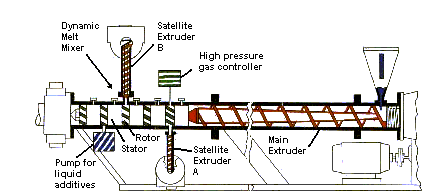|
A Dynamic Melt Mixer provides superior mixing in a very simple setup, which is beyond the mixing capabilities of other mixers
and extruders, even twin-screw extruders. The Mixer can be simply attached to existing single-screw or twin-screw extruders
as a component. It can be driven by the extruder or independtly, giving the mixer great flexibility. The Mixer is particularly
useful in applications where homogeneous mixing is critical (see the Applications page). It offers a number of advantages
over other mixing apparatus and technologies, which are listed below:
Advantages of a dynamic mixer:
- easy setup on existing single-screw or twin-screw extruders
- minimum exposure to
shear and high temperatures
- minimum changeover time
- outstanding distributive mixing in short pipe length(ca.
1/6 of what static mixers require)
- minimum pressure drop (ca. 1/4 of what static mixers produce)
- excellent
melt thermal homogenization
- low frictional heat build-up
- capable of developing high operating pressures,
ca. 8000 psi
- low cost
Dynamic Melt Mixer

Schematic of a Dynamic Melt Mixer
A single-screw extruder equipped with a dynamic mixer apparatus generally consists of a main extruder, one or more satellite
extruders, inlets for the addition of liquid additives, e.g. solvent or plasticizer, and rotors and stators inside the barrel
of the dynamic mixing apparatus. The barrel of a dynamic mixer apparatus is attached onto the down stream end of the barrel
of the extrusion machine. A support shaft in the dynamic mixer apparatus rotatively carries a plurality of rotors and stators
within the dynamix mixer barrel. Efficient mixing is achieved via the use of rotors and stators. The introduction ports may
also be used to withdraw samples or as vent ports. Alternatively, the rotor of the dynamic mixer may be positioned to present
a shaft with a rotor of opposite hand to provide a flow retarding characteristic.
The support shaft of the Dynamic Melt
Mixer may be driven by the shaft of the main extruder or it may be driven separately if different torque is desirable. The
Dymamic Melt Mixer can also be attached to a twin-screw extruder.
Principles of Polymer Mixing in a DMX Dynamic Melt Mixer
In laminar flow, fluid moves in layers with parallel streamlines. No mixing will occur other than by diffusion which is extremely
slow. In order to mix two or more streams or components one must divide/cut the fluid flow perpendicular to the direction
of flow and reorient it close to ninety degrees to its original flow direction. This principle is used in all plastic melt
mixers such as Sigma blades, Branbury mixers, twin screw extruders and motionless mixers. The DMX Dynamic Melt Mixer also
uses this principle and improves upon it by having the option to either couple the DMX Dynamic Melt Mixer to a screw of a
single screw extruder or drive it independently so that the conveying action is separated from the mixing action.
In
the Dynamic Melt Mixer unit, the melt flows axially from the inlet to the outlet, and superimposed upon it is the flow perpendicular
to the axial flow due to the rotation of the rotor elements which reorient the flow and then force it through a set of stators
that reorient it again. In the rotor design the rotor movement cuts the streamlines. The angle is close to 90 degrees, but
usually a bit less so that some conveying action in the axial direction is also introduced. The number of elements, their
speed of rotation, and the conveying angle thus controls mixing, conveying and residence time. For successful mixing, one
has to control residence time, temperature and shear. The total time determines the shear history. In process equipment, the
shear rate is a function of geometry and boundary conditions. The shear rate is the change in axial velocity over distance
(dv/dr, derivative).
The shear rate also generates frictional heating (viscous dissipation) which changes the melt temperature,
which in turn affects the viscosity. A minimum shear rate is required to pull particles (or components) apart. The mixing
is usually considered to be two types: (a) distributive mixing - low shear rates where the components are spatially distributed
due to the mixing principle mentioned above, and (b) dispersive mixing - high shear regions in narrow gaps between moving
surfaces where moving particles are torn apart and reduced in size.
As the melt temperature goes up, the viscosity decreases,
and the required shear stresses for dispersion decrease. The melt temperature also lowers the surface tension. The dispersed
phase wants to minimize area (like a raindrop) and will formspherical particles. These particles deform in the shear field
and finally break when the shear stresses reach a minimum threshold. In the absence of a shear field, particles tend to become
round, and may also agglomerate. This subject is very complex, and depends on thermodynamics. Both surface tension and thermodynamics
determine which component becomes the minor dispersed component. This can happen spontaneously and is called phase inversion.
The DMX Dynamic Melt Mixer affords control over these variables since it controls the shear rate vis--vis the independent
drive, the temperature being controlled by viscous dissipation (again by drive speed control) and external heating by heater
bands or cooling by a cooling jacket around the surface of the DMX Dynamic Melt Mixer. Finally, the number of elements, their
geometry and their speed of rotation determine the residence time over which the melt and its constituent components are mixed.
Thus, the shear and temperature history of the melt are controlled more readily in the Dynamic Melt Mixer.
|